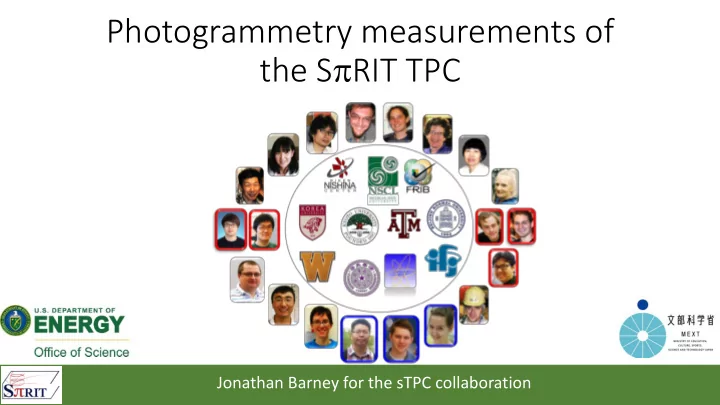

Photogrammetry measurements of the S p RIT TPC Jonathan Barney for the sTPC collaboration
S p RIT Time Projection Chamber • Built to study the symmetry energy at ~2 r 0 1.34 m 0.86 m • Multi-wire proportional chamber • Large pad plane for particle detection (12,096 channels) • Designed, constructed and assembled at MSU & TAMU 2
S p RIT Time Projection Chamber • Built to study the symmetry energy at ~2 r 0 • Multi-wire proportional chamber • Large pad plane for particle detection (12,096 channels) • Designed, constructed and assembled at MSU & TAMU • Shipped to RIKEN (~10,000 km trip) 3
S p RIT Time Projection Chamber • Built to study the symmetry energy at ~2 r 0 • Multi-wire proportional chamber • Large pad plane for particle detection (12,096 channels) • Designed, constructed and assembled at MSU & TAMU • Shipped to RIKEN (~10,000 km trip) • Will operate inside SAMURAI magnet at RIKEN 4
S p RIT Time Projection Chamber • Thin walled enclosure with angle iron (aluminum) frame • Field cage made of G10 circuit board • Thick aluminum plate with ribs designed to keep detection elements fixed 5
Important measurements Flatness of the pad plane • Distance from pads to wires affects gain of detector • Measure pad plane by measuring top plate Pad plane is attached to large aluminum plate 6
Pad plane Original Laser measurements • Flatness measured using FARO laser system at NSCL during assembly • Flat within 125 m m • Flatness of pad plane within machining tolerances of top plate 7
Important measurements • Angle of field cage to pad plane • Affects drift path of electrons • Also affects simulations 8
Important measurements • Check position inside magnet chamber • Adjust so that E field is parallel to B field • Check position of detection elements relative to beam line TPC inside SAMURAI magnet 9
Photogrammetry measurements on the TPC • Photogrammetry is the measurement method available at RIKEN • Study performed by Justin Estee, July 2014 • 3 studies: • Flatness of top plate • How parallel is field cage • Changes to TPC on uneven surface Figure courtesy B. Brophy 10
How does photogrammetry work? • Use multiple images to triangulate points on a 3D object • “Resection” to determine the position of the camera for each http://www.geodetic.com/v-stars photo • Geodetic V-stars program reconstructs a 3D image of the points http://www.clemson.edu/restoration/wlcc/equipment_services/equipment/photogrammetry.html 11
Resection • Use coded targets as unique points • Coded targets in picture help identify which face is photographed • Requires a scale • Scale bar included in measurements Is this the mama or the baby? The size is now evident http://www.clemson.edu/restoration/wlcc/equipment_services/equipment/photogrammetry.html 12
Study of accuracy • Measurement of a granite flat plate (1.35 x 0.9 m) • Flatness expected to be within 125 m m (or better) • Measured with photogrammetry Standard Deviation [ m m] Max/Min [ m m] Target style 6-Single targets 20 +16/-19 38-tape targets 24 +52/-47 42-tape targets 23 +57/-46 • Accuracy of photogrammetry measurements is within machining tolerance 13
Photogrammetry measurements on the TPC 14
Checking measurements • The measured points can be analyzed with V-stars program • Points can also be exported to check against 3D design • Check position of field cage relative to reference points 15
Initial location 83% within +/-48 m m • Baseline measurement to see how flatness changes Deviation from average plane (mm) 16
Moved across floor Initial location 83% within +/-48 m m ~72% within +/-48 m m Deviation from average plane (mm) 17
Changes to TPC on unleveled surface • Lifted one side to determine if warping occurs • Also check field cage to determine if position changes 18
Lifting up one side of TPC • Minimal deviation from original measured plane – within 48 m m • Overall flatness does not change more than +/- 75 m m Deviation from original measurement (mm) 19
Orientation of field cage • The exact angle of the field cage determines the electrical field. • Panels were removed to measure the field cage • Within 2 miliradians of design value for all measurements • Provides position of field cage against reference points 20
Summary • S p RIT TPC pad plane is within expected flatness, even when not on a level surface • Field cage is within 2 miliradians of expected value • We will be able to position and level detector using photogrammetry 21
Thank you! This material is based on work supported by the DOE under Grant No. DE-SC0004835, NSF under Grant No. PHY- 1102511 and the Japanese MEXT Grant-in-Aid for Scientific Research on Innovative Area Grant No. 24105004 22
Recommend
More recommend